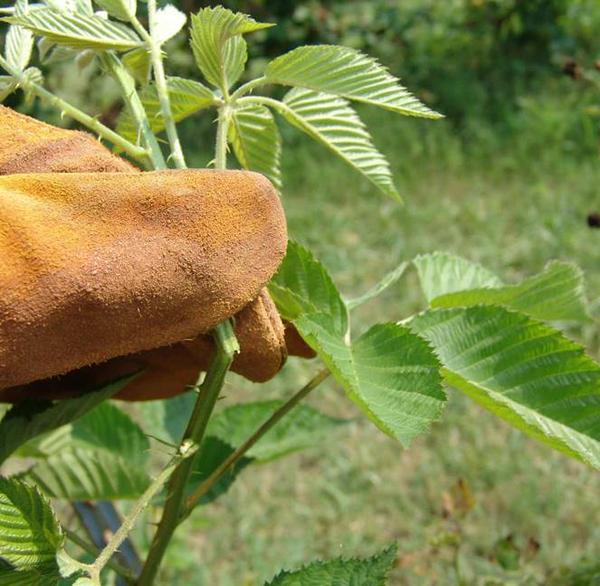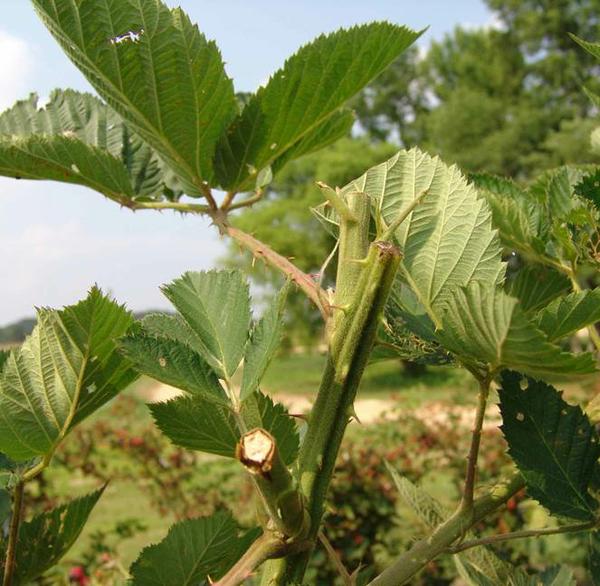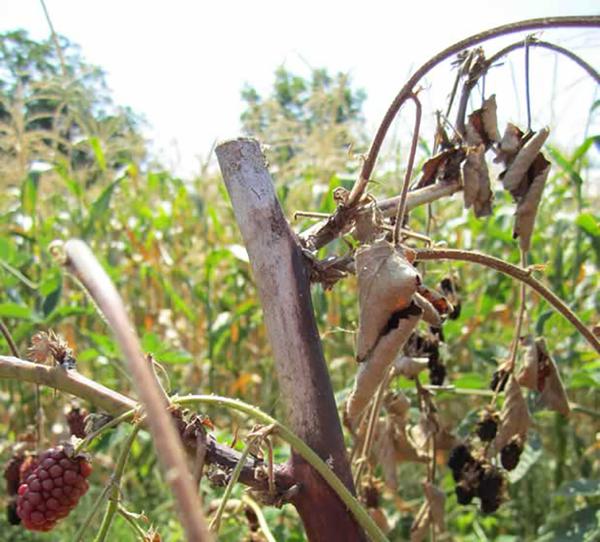General
All blackberries and raspberries must be pruned and trained. Floricane-fruiting caneberries need pruning several times a year. Primocane-fruiting raspberries need to be pruned (mowed) once a year during the winter.
Erect Floricane-Fruiting Blackberries
During the first year, erect floricane blackberry plants establish root systems and grow a moderate number of primocanes. Their growth habit in the first year can be more trailing, like a dewberry. Attach these flexible canes to the trellis by wrapping the canes loosely to the wire and then securing them to the wire. The growth habit of the primocanes in the second and subsequent years will be erect. To properly train erect types, allow the primocanes to develop in a row approximately 12 in. wide at the base during the growing season. Most newly emerging primocanes will grow in the center of the row. Although these primocanes are still flexible, encourage them to grow up in between the two sides of a T or V-trellis by pushing them into the center of the row before they reach the trellis’s bottom wire.
Summer Tipping
The new shoots, primocanes, of erect blackberries should be tipped in year two and onward when they reach 8 to 12 in. above the top wire. Tipping encourages the growth of lateral branches on which fruit is produced the following year. Use your fingers to pinch off 2 to 4 in. of the tender new growth at the tip of the cane—known as soft tipping (Figure 6-1 and Tipping Blackberry Primocanes). If tipping is missed when the new growth is tender, the cane will become thicker and woodier at the height at which the plant should be tipped. In this case, use loppers (two-handed tools that cut medium-sized branches) or a mechanical hedger capable of making a clean sharp cut, which is known as “hard tipping” (Figure 6-2). Tipping or hedging can lead to cane blight disease, Leptosphaeria coniothyrium, especially if the cuts are made just before a rain event (Figure 6-3). Soft tipping early by pinching young growth invites less disease than hard tipping. After tipping, apply a preventative fungicide to protect cuts from cane blight. The Cane Blight of Blackberry factsheet contains more information about this disease.
Tipped primocanes will grow stout and be more capable of supporting a heavy fruit crop the following year. In southern Georgia, many thornless cultivars produce only one to three large primocanes each year. In this case, tip the canes during the summer when they attain a height of 2 to 3 ft to encourage branching.
Late Summer and Winter Pruning
After fruiting, remove dead floricanes and thin out weak primocanes as time permits. In late winter, prune the lateral branches to 12 to 18 in. as needed. Some cultivars can be quite vigorous and produce lateral branches that are several feet long. Plants that are allowed to produce fruit on excessively long laterals may be prone to overcropping, which will result in small fruit of poor quality. Pruning will also increase air, sunlight, and spray penetration within the row. This will make harvesting more convenient and result in larger berries. Where large-diameter pruning cuts are made, stem disease has been severe in some years. A fungicide application after pruning is recommended. At the same time, remove any remaining dead or weak wood. Leave only about six to eight healthy, vigorous, evenly spaced canes per linear yard (3 ft) of row.
Erect blackberries must be trellised for additional support and for ease of harvest. Follow the trellising guidelines for trailing and semi-erect types using one of the trellises described in the Trellis Systems section of this publication.
Semi-Erect and Trailing Floricane-Fruiting Blackberries
During the first growing season, tie semi-erect and trailing blackberry primocanes to a trellis to allow for weed control under the canes. Securing the canes to the trellis can be done with trellis clips, soft string, or plastic tape from a hand-held device designed for tying caneberries and grapes. In late winter, prune the lateral branches to 10 to 12 in. in length. If 3 ft or more of cane growth was produced the first year, cropping can occur in the second year. If there was only a small amount of growth in the first year, cut the canes back to within several inches of the ground. This practice helps the plants become better established by preventing severe stress on their productivity due to fruiting, and favors the development of sturdier, more fruitful shoots in the subsequent year. In the succeeding years, new shoot growth will be more vigorous.
Primocanes of trailing and semi-erect blackberries are extremely vigorous and need to be managed throughout the summer. Tie primocanes loosely together as they develop, and train them up through the plant to the top wire. After they have reached the top wire, divide and tie them to the wire. This method is well suited for semi-erect and less vigorous trailing cultivars. Uniform placement of the lateral canes along the trellis wires will maximize light exposure and yield.
Primocane-Fruiting Blackberries (Single or Double Cropped)
Single Cropped
During the late winter or early spring, remove all canes at the base before growth begins in spring. Fruit will be produced on new primocanes in the late summer or fall. Primocanes should be soft tipped (remove about 2 in.) when they reach 3 ft in height. Continue the soft-tipping process throughout the growing season as new primocanes emerge from the ground. In the western US, growers have found that yields increase when canes are soft-tipped twice, once on the primary canes at 1.5 to 3 ft and then again on each lateral branch at 1.5 ft. Hard-tipping with pruners is not recommended for primocane-fruiting blackberries, because the wounds created by the cuts will increase the likelihood of infection by pathogens (Figure 6-3). To produce a late-season crop at lower elevations, cut the canes to the ground in the early spring before growth begins. When they are approximately 1 ft tall, prune the canes to near ground level a second time. Pruning in this manner will help to delay harvest until late summer after the heat of the summer has passed.
Double Cropped
Primocane-fruiting blackberries can also be managed with the biennial system, with a first crop on the floricanes and a second crop on the primocanes. In this case, follow the recommendations for both primocane and floricane-fruiting blackberries. However, during the winter, as opposed to cutting them to the ground, primocanes should be pruned to just below the height where fruit production stopped in the fall. Fruit will be produced on the lower parts of these floricanes in the subsequent summer. In the spring and summer, soft tip the new growth of primocanes as described above. Remove floricanes by hand after harvesting the fruit.
Floricane-Fruiting Raspberries
The biennial system is the most common training and pruning system in the eastern US for summer fruiting raspberries. In this system, primocanes are allowed to grow throughout the season. In most cases, floricanes that produced fruit are removed immediately after fruiting to increase air movement and decrease disease pressure in the canopy. However, in colder regions of the South, these canes may serve as a source of stored carbohydrates for cold protection in the winter. Growers in the mountain regions may consider pruning floricanes after the coldest part of the winter. In early spring, top prune the remaining canes to a convenient picking height (usually 3 to 4 ft). If canes are too dense, fruit size will be reduced. If canes are thinned too much, total yield will suffer. In early spring, remove weaker canes and thin the remaining canes to three to four canes per square foot. Leave only the most vigorous canes, which are those with good height, large diameter, numerous nodes in the fruiting zone, and no obvious signs of disease, insect damage, or winter injury.
Publication date: Feb. 23, 2023
AG-697
Other Publications in Southeast Regional Caneberry Production Guide
- Introduction
- Cultivars
- Site Selection
- Site Preparation, Planting, and Establishment
- Plant Growth
- Pruning and Training
- Trellis Systems
- Tunnel Production
- Water Management
- Integrated Pest Management and Pollination
- Fertility Management
- Fruit Development
- Harvesting and Postharvest Management
- Food Safety Considerations for Caneberry Production
N.C. Cooperative Extension prohibits discrimination and harassment regardless of age, color, disability, family and marital status, gender identity, national origin, political beliefs, race, religion, sex (including pregnancy), sexual orientation and veteran status.



